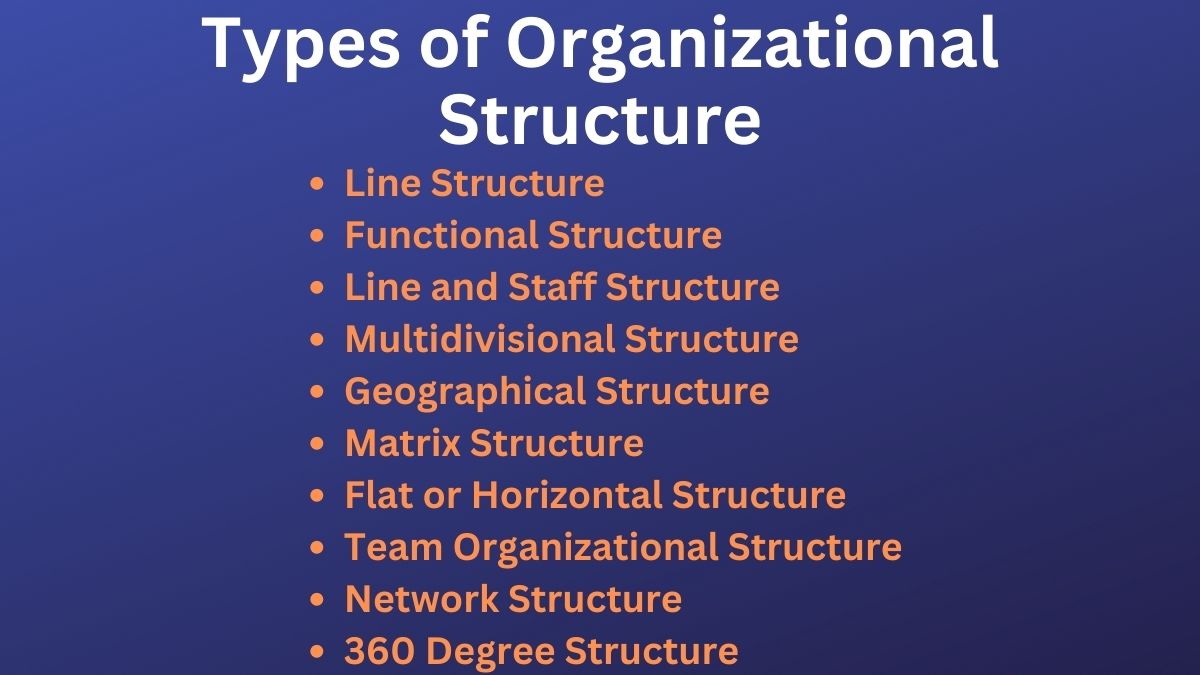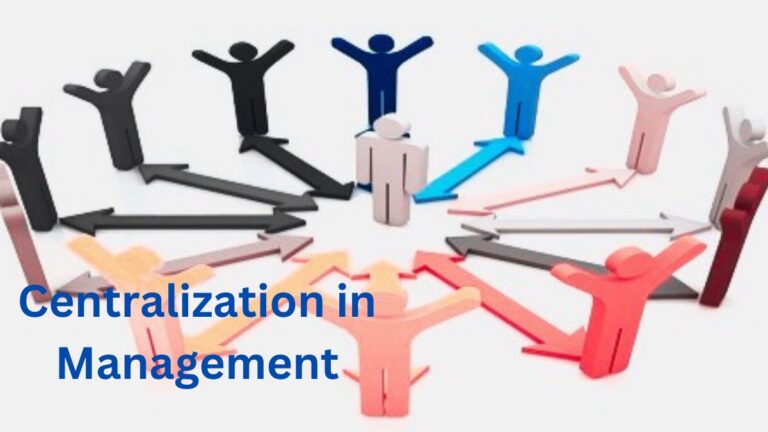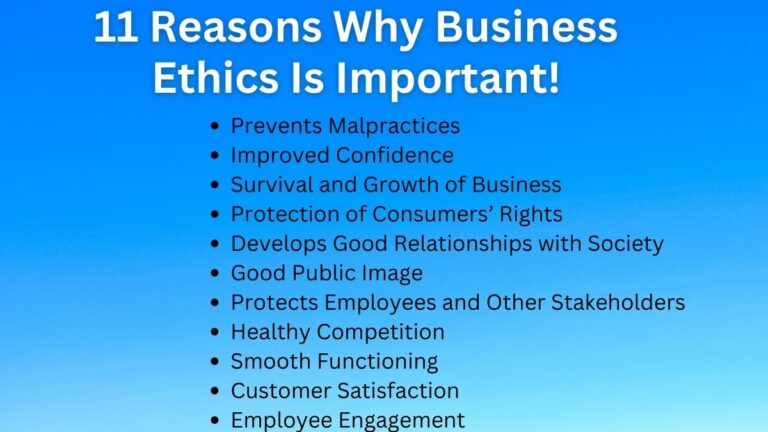10 Types of Organizational Structure Found in the Workplace [Explained]
Types of Organizational Structure
An organizational structure is a system that lets employees know how they should work to achieve the organization’s common goals. There are several types of organizational structures you can choose to implement in your company.
Let’s discuss the 10 most common organizational structures with their advantages and disadvantages so you can further decide which one is fit for your organization.
Line Structure
Line structure is the oldest and simplest type of organizational structure than others types. In this structure, there is a clear hierarchy of authority in which authority flows vertically i.e. from top to bottom and responsibility flows from the bottom to top.
It is a centralized organizational structure as such the decision-making power is vested only in top management. It is rigid in nature, however, everyone is clear about their duties and authority-responsibility relationships. In such an organization employees must abide by the guidelines and instructions of the top manager.
Advantages:
- Simple and easy structure.
- Quick decisions can be made.
- Unified control can be achieved.
- Clear responsibility and authority relationship.
- There is fixed responsibility.
Disadvantages:
- Overload on top officials.
- It is a rigid structure.
- Autocracy.
- Not suitable in a modern business setting.
Functional Structure
Functional structures provide specialization benefits. It groups similar nature of tasks into different functional departments. Each department only performs specific tasks. And, at the core of this, all functional departments support the achievement of the organization’s common goals.
For each department, a functional specialist (manager) is put in charge who then takes care of the performance of his/her respective departments. He has the autonomy to exercise his departmental operations as he sees fit, however, he must be responsible for his performance and report to the top officials.
Advantages:
- Provides benefits of specialization.
- Reduces workload of top managers.
- Increases efficiency.
- Suitable for present business settings.
Disadvantages:
- There is a lack of unity of command.
- It is a costly structure that requires high administration costs.
- There can be delays in decision-making.
Line and Staff Structure
The recently discussed two above organizational structures made up the line and staff organizational structure. The main goal of this organizational structure is to minimize the weaknesses of the line and functional structure and strengthen them.
It tries to make a balance between them. In this structure, there are advantages and disadvantages of both types of organizational structures (line and functional structure).
In addition, here comes line and staff authority. Staff authority is responsible for making plans whereas line authority should implement those plans in the practical field.
Also Read: Delegation of Authority
Advantages:
- Benefits of specialization.
- Better decisions can be made.
- Better coordination.
- Relief to the top managers.
Disadvantages:
- There is a potential for conflict.
- It is also a costly structure.
- There may be over-dependence on staff.
Multidivisional Structure
In a multidivisional structure, the products of an organization are divided into different divisions. Often these divisions completely work as a separate entity. Each division has the independence to make decisions on its own. However, each division should be contributing to the overall goal of the company.
General Electric is a good example that uses M-form organizational structure. It has product divisions such as energy, capital, home & business solutions, healthcare, aviation, and transportation.
Advantages:
- Creates portfolio of the organization.
- Helps in business expansion.
- Increases organizational effectiveness.
- Ensures promotion of divisional managers.
Disadvantages:
- There may be a lack of proper coordination between different divisions.
- It is also a costly structure.
- Divisions may compete for scarce resources.
Geographical Structure
As the name suggests, the geographical organizational structure creates the organization’s structures based on the operations in different geographic locations. Such attempts further make companies to be more responsive in respective locations, which may be regions, a country, or countries.
It is a suitable structure for organizations operating in different locations as well as one which is planning to expand its operations into new locations. Due to globalization, the geographical structure is being more popular nowadays.
Advantages:
- Better customer service can be achieved.
- Improved customer communication.
- Suitable for large organizations.
- Flexible and adaptive.
- Ensures quick decisions.
Disadvantages:
- Costly structure.
- Chance of miscommunication.
- There may be competition for resources.
- This may lead to inefficient operations due to too much autonomy given to regional authorities.
Matrix Structure
In a matrix structure, the reporting relationships are set up as a grid, or matrix, rather than in the traditional hierarchy. Here, different functional disciplines of employees are pooled together to accomplish specific projects.
In particular, matrix organizational structure combines functional and project structure. As such, each employee working under a matrix structure has to work under two managers (functional and project managers) simultaneously.
It certainly increases the employee’s workload since they are pooled together with other employees without removing from their regular work.
Advantages:
- Benefits of specialization.
- Employee development.
- The unique problem can be solved or the target can be achieved.
- Optimal use of human resources.
- Promotes teamwork.
- Dynamic structure.
Disadvantages:
- It is a complex organizational structure.
- No unity of command.
- Difficult to balance.
- Over workloads to employees.
Flat or Horizontal Structure
An organizational structure is said to as flat if there are few or no layers of management between senior and staff-level individuals. The flat structure is implemented in order to eliminate the drawbacks of line structure, such as a longer scalar chain, the potential for decision delay, and low employee satisfaction.
A flat structure allows for close staff supervision, which boosts productivity, a sense of strong belonging, and the ability to make quick decisions.
Advantages:
- Improves the coordination and communication between employees.
- Facilitates prompt decision-making.
- A good opportunity for employee growth.
- Raises the level of employee satisfaction and self-responsibility among employees.
Disadvantages:
- There may be reporting confusion and power struggles.
- Fails to produce specialists.
- This may limit the long-term growth of the organization.
Team Organizational Structure
As its name suggests, the team organizational structure includes the creation of different work teams in the organization to achieve the desired goals. Under the team structure, normally three types of team organizational structure come. They are:
First, the project team in which a team of specialists and professionals is created to attain a specific project. Second, the task force in which a team of top executives and experts is created to solve the specific issue of the organization. Third, a venture team is created to launch a new venture, business, or product.
Advantages:
- Effective communication.
- Ensures team spirit in the workplace.
- Low supervision and control.
- Better decisions since teams have the freedom to make decisions.
Disadvantages:
- The potential of conflict.
- The decision can be delayed because of no consensus among team members.
- Creates interdependency.
Related: Esprit De Corps Principle
Network Structure
In comparison to other types of organizational structures, the network structure is more recent and is thought to be less hierarchical, more decentralized, and more flexible. Managers organize and oversee relationships that are both internal and external to the company under this structure. It is based on social interaction networks.
Complex networks at the industry level can comprise technology and innovation networks that span numerous locations and companies. Social networks can be intra or inter-organizational at the organizational level, reflecting formal or informal interactions to carry out tasks focusing on achieving organizational goals.
Advantages:
- It is more agile compared to other structures.
- Free flow of communication possibly opens up opportunities for innovation.
- Decentralized strucutre.
- A wide span of control.
Disadvantages:
- This structure is more fluid structure which can lead to a more complex set of relationships in the organization.
- Lines of accountability can be less clear.
- There can be reduced control over operational success.
360 Degree Structure
A new method of thinking called the 360-degree elaborates on the efficiency of team structure. Each manager assumes accountability, responsibility, and decision-making power in this organization. Under the framework, every member exchanges ideas, opinions, and comments with every other member to foster greater cooperation, coordination, and understanding.
The 360-degree organizational structure places a strong emphasis on the contributions of the workforce, as well as on their skills and competencies. In terms of cooperation, leadership, interaction, communication, mutual and self-defined contributions, reciprocal accountability, and the sincerity of employees’ work habits, it is a balanced way to assess how well people actually performed.
Advantages:
- Provides more accurate 360-degree assessment.
- Employee participation increases motivation.
- The feedback from colleagues lets employees look at their self-strengths.
- More influential opinions can be gathered from participants.
Disadvantages:
- It is a lengthy process and the conclusion takes more time.
- Employees should be competent in effectively using the 360-degree structure.
Hence, these are the 10 types of organizational structures companies are using. Choose one that is suitable to your company’s nature, products, and financial conditions.
Read Also: Mechanistic Vs. Organic Organizational Structure
Sajan Kushmi is a content writer with more than 4 years of experience. He holds BIM Degree. He write on the topics related to Management, Marketing, and Entrepreneurship.






